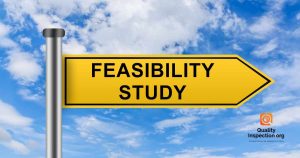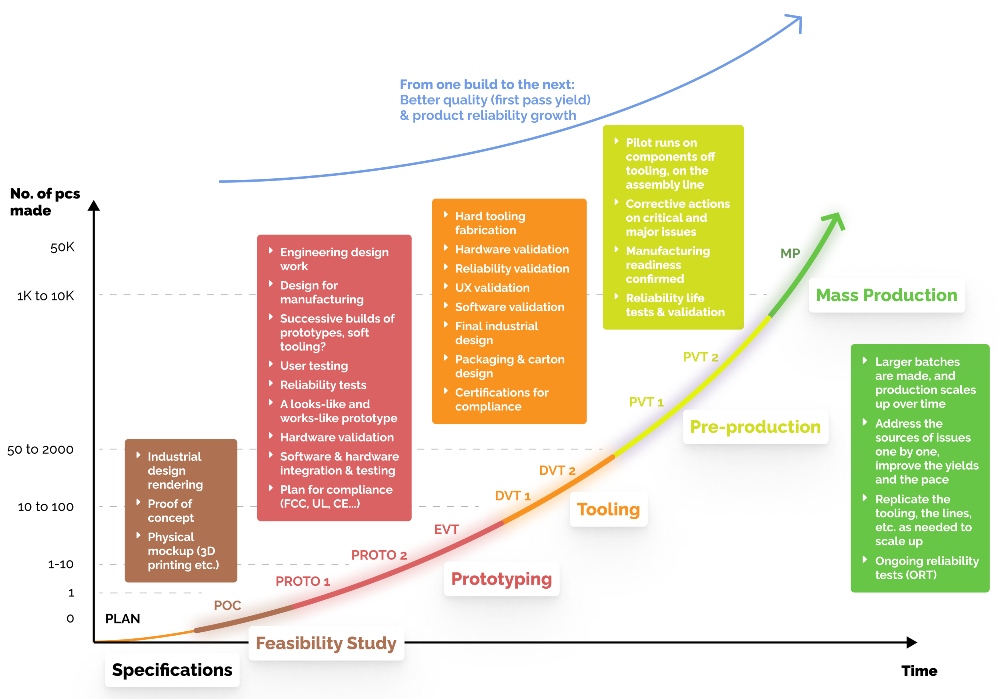We’re exploring what a feasibility study for new products is, its benefits, and everything you need to know in order to implement yours. This will really help you to identify potential issues long before you manufacture your product, saving time and money on correcting them or suffering the headache of a failed product later on.
Prefer listening to reading?
What is a feasibility study?
A feasibility study is a thorough assessment and analysis done by a manufacturer during the early stages of new product development to offer confirmation that the product they’re trying to develop and bring to market can be done with the minimum of risks. You can see when it is done below:
The study itself is not just one task, it’s a phase of activities. Various tools and techniques, such as a dFMEA, will be done to analyze different factors that can affect the ability to bring a manufacturable product to market that will reach your own and your customers’ expectations. These factors include:
- Checking the market demand by getting feedback on early prototypes and designs from potential customers who use it
- Gaining an understanding of product and component costs and building an initial BOM
- Having engineers provide their opinions on how the product designs are technically feasible
- Preparing rough prototypes, doing early performance testing, simulations on CAD models, etc.
- Researching if there are any regulatory compliance requirements that will influence the product and must be planned for before manufacturing can take place
- Researching what the risks of manufacturing the product are and putting in place DFM improvements
Benefits of doing a feasibility study.
A feasibility study empowers you to make informed decisions about if your product design can be developed and launched. It will highlight the product risks while you’re still in an early enough part of the design and development process to make changes without them costing a lot of time and money. Ultimately, the investment into the study will pay itself back easily as you’ll know that you can go ahead and launch your new product with fewer risks and a better chance of success.
The ‘Just Do It’ or ‘Go’ syndrome is the biggest mistake to avoid.
Companies who do design and engineering in-house usually have engineers or CTOs who are accountable for the product’s success and so they willingly do a feasibility study in order to reduce the risks of wasting a lot of time and money on developing a product that can’t be manufactured. But if the design and development are outsourced to a 3rd party the focus is often on getting the prototype instead of taking time to check the product’s feasibility. With the early prototype in hand, the company makes promises to customers, books booths at trade shows, etc, but then after the product goes into production they find there are numerous problems that come back to bite them because a feasibility study wasn’t done first and the promises they made cannot be fulfilled.
A typical example:
A small product like a smartwatch with a metal enclosure has Bluetooth and needs to communicate with a phone. The metal can be problematic when it comes to blocking the Bluetooth signal, so you may need a stronger antenna or place it in a location where the metal doesn’t affect the signal. If the company has spent 6 months designing and developing the product and the problem with the antenna and case is only caught during final testing before it goes into production, a redesign may be required including the casing, different components, changes to the firmware, etc. This redesign process might take another few months, it’s costly, and it annoys the big customers who promised the product at a certain time. However, the extra time, cost, and negative effect on your business could have been avoided if a feasibility study had been done early on which would have pinpointed that the metal casing was a risk.
The same could be said for a product that has, say, a fan that uses energy. You need to know that the battery is large enough before you manufacture the product. Or a product that has in-built software, you need to know that it has enough memory to hold the software in advance in order for the product to function properly.
Basically, taking time to do the feasibility study will reduce your risks and result in a product that does reach your standards and those of your customers.
What if a product is rushed into mass production?
It can sometimes be Chinese manufacturers who rush to mass production and skip important NPI steps like the feasibility study, but it’s often actually the inventors themselves who drive the project in this way, not their suppliers. They often want to go fast and underestimate the difficulties.
There are numerous high-profile crowdfunding failures out there in public that we can see fail for technical reasons because the feasibility study was obviously skipped. For example, probably the most high-profile was the case of the ‘Coolest Cooler’ which raised US$13 million from backers! This cooler had so many interesting functions that it turned out to be unfeasible and they were left with just a cool-looking prototype and thousands of angry backers.
Tips on how to do your own feasibility study based on how large businesses conduct theirs.
Some tools are widely used by big companies to improve their processes, have a reliable NPI process, etc.
- Design FMEA – At the early design stage you start to think of risks what might go wrong, probability, impact, the highest sources of risks and what can be done to mitigate them.
- FTA – fault tree analysis, what are the big problems that can happen, what leads to them, investigate causes step by step that result in problems in order to find and stop them.
- QFD – quality function deployment, find out what attributes the market wants and then the product needs to have functions and performance that fulfill them, what does this mean for the manufacturing process and selection of materials? Use a template to gather this info.
These tools force the design and engineering teams to do studies and produce certain deliverables:
- An initial BOM
- A report on compliance requirements that may affect the product
- An initial plan for product and process features
- A report on how mature the mfg processes are and if there is a risk of issues there, e.g. painting silicone which is technical, costly, and could slow the process down
- A plan for how to verify the product’s quality, including jigs, fixtures, and testing stations required
It’s better to spend some time and money on this planning early on in the way that large companies do, as the investment will help reduce mistakes and give direction to the design afterwards.


